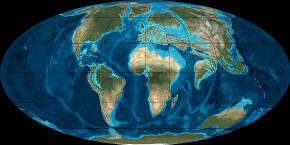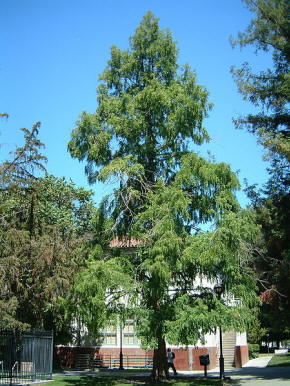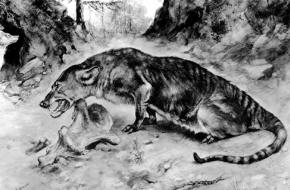The name Eocene comes from the Greek ἠώς (eos, dawn) and καινός (kainos, new) and refers to the "dawn" of modern ('new') mammalian fauna that appeared during the epoch.
Climate
Earth's surface temperatures generally rose from the late Paleocene through the Early Eocene (~59 - 50 Ma), reaching maximum Cenozoic temperatures during the Early Eocene Climatic Optimum (EECO). Superimposed on this warming were a series of "hyperthermals". These are best described as geologically brief (less than 200,000 year) events characterized by rapid and extreme global warming. The most prominent of these is the Paleocene-Eocene Thermal Maximum or Initial Eocene Thermal Maximum (PETM or IETM), which began at the Paleocene-Eocene Boundary. This was an episode of rapid and intense warming (up to 7 °C at high latitudes) that lasted less than 200,000 years. The Thermal Maximum coincided with a major mammalian turnover on land (that distinguishes Eocene fauna from Paleocene fauna), and an extinction of many benthic foraminifera species in the deep sea.
The Eocene global climate was perhaps the most homogeneous of the Cenozoic; the temperature gradient from equator to pole was only half that of today's, and deep ocean currents were exceptionally warm. The polar regions were much warmer than today, perhaps as mild as the modern-day Pacific Northwest; temperate forests extended right to the poles, while rainy tropical climates extended as far north as 45°. The difference was greatest in the temperate latitudes; the climate in the tropics however, was probably similar to today's. The recent discovery of a giant snake (estimated length 13 m) in Colombia that may have lived during the Eocene suggests, on the contrary, that the tropics were much warmer than today, a conclusion in accord with numerical simulations of the climate during the Eocene.
Although the global climate remained comparatively warm throughout the rest of the Eocene it was this epoch that marked the start of a slow global cooling trend, possibly triggered by the Arctic Ocean Azolla event and the formation of the Antarctic circumpolar current following the final break up of Gondwana. This trend would eventually lead to the Pleistocene glaciations.
Paleogeography
During the Eocene, the continents continued to drift toward their present positions.
 |
| Paleogeography during the Eocene, approximately 50 Ma (Picture Source) |
At the beginning of the period, Australia and Antarctica remained connected, and warm equatorial currents mixed with colder Antarctic waters, distributing the heat around the planet and keeping global temperatures high. But when Australia split from the southern continent around 45 Ma, the warm equatorial currents were deflected away from Antarctica, and an isolated cold water channel developed between the two continents. The Antarctic region cooled down, and the ocean surrounding Antarctica began to freeze, sending cold water and icefloes north, reinforcing the cooling.
The northern supercontinent of Laurasia began to break up, as Europe, Greenland and North America drifted apart.
In western North America, mountain building started in the Eocene, and huge lakes formed in the high flat basins among uplifts, resulting in the deposition of the Green River Formation lagerstätte.
In Europe, the Tethys Sea finally vanished, while the uplift of the Alps isolated its final remnant, the Mediterranean, and created another shallow sea with island archipelagos to the north. Though the North Atlantic was opening, a land connection appears to have remained between North America and Europe since the faunas of the two regions are very similar.
India continued its journey away from Africa and began its collision with Asia, folding the Himalayas into existence.
It is hypothesized that the Eocene hothouse world was caused by runaway global warming from released methane clathrates deep in the oceans. The clathrates were buried beneath mud that was disturbed as the oceans warmed. Methane (CH4) has ten to twenty times the greenhouse gas effect of carbon dioxide (CO2).
Flora
At the beginning of the Eocene, the high temperatures and warm oceans created a
 |
| Dawn Redwood (Picture Source) |
Polar forests were quite extensive. Fossils and even preserved remains of trees such as swamp cypress and dawn redwood from the Eocene have been found on Ellesmere Island in the Arctic. The preserved remains are not fossils, but actual pieces preserved in oxygen-poor water in the swampy forests of the time and then buried before they had the chance to decompose. Even at that time, Ellesmere Island was only a few degrees in latitude further south than it is today. Fossils of subtropical and even tropical trees and plants from the Eocene have also been found in Greenland and Alaska. Tropical rainforests grew as far north as the Pacific Northwest and Europe.
Palm trees were growing as far north as Alaska and northern Europe during the early Eocene, although they became less abundant as the climate cooled. Dawn redwoods were far more extensive as well.
Cooling began mid-period, and by the end of the Eocene continental interiors had begun to dry out, with forests thinning out considerably in some areas. The newly-evolved grasses were still confined to river banks and lake shores, and had not yet expanded into plains and savannas.
The cooling also brought seasonal changes. Deciduous trees, better able to cope with large temperature changes, began to overtake evergreen tropical species. By the end of the period, deciduous forests covered large parts of the northern continents, including North America, Eurasia and the Arctic, and rainforests held on only in equatorial South America, Africa, India and Australia.
Antarctica, which began the Eocene fringed with a warm temperate to sub-tropical rainforest, became much colder as the period progressed; the heat-loving tropical flora was wiped out, and by the beginning of the Oligocene, the continent hosted deciduous forests and vast stretches of tundra.
Fauna
The oldest known fossils of most of the modern mammal orders appear within a brief period during the early Eocene. At the beginning of the Eocene, several new mammal groups arrived in North America. These modern mammals had features such as long, thin legs, feet and hands capable of grasping, as well as differentiated teeth adapted for chewing. Dwarf forms reigned. All the members of the new mammal orders were small, under 10 kg; based on comparisons of tooth size, Eocene mammals were only 60% of the size of the primitive Paleocene mammals that preceded them. They were also smaller than the mammals that followed them. It is assumed that the hot Eocene temperatures favored smaller animals that were better able to manage the heat.
Both groups of modern ungulates (hoofed animals) became prevalent because of a major
 |
| Mesonyx |
Reptile fossils from this time, such as fossils of pythons and turtles, are abundant. The remains of a giant snake of the size of a school bus has recently been discovered; such a massive snake would have not survived were the tropics as warm as today, contradicting previous conclusions drawn from other proxies for temperature.
During the Eocene, plants and marine faunas became quite modern. Many modern bird orders first appeared in the Eocene.
Oceans
The Eocene oceans were warm and teeming with fish and other sea life. The first Carcharinid sharks appeared, as did early marine mammals, including Basilosaurus, an early species of whale that is thought to be descended from land animals that existed earlier in the Eocene, the hoofed predators called mesonychids, of which Mesonyx was a member. The first sirenians, relatives of the elephants, also appeared at this time.
Eocene-Oligocene Extinction Event
The transition between the end of the Eocene and the beginning of the Oligocene, called the Grande Coupure in Europe, occurring 33.9 ± 0.1 Ma, is marked by large-scale extinction and floral and faunal turnover (although minor in comparison to the largest mass extinctions).
Most of the affected organisms were marine or aquatic in nature. They included the last of the ancient cetaceans, the Archaeoceti.
This was a time of major climatic change, especially cooling, not obviously linked with any single major impact or any major volcanic event. One cause of the extinction event is speculated to be volcanic activity. Another speculation is that the extinctions are related to several meteorite impacts that occurred about this time. One such event happened near present-day Chesapeake Bay, and another the Popigai crater of central Siberia, scattering debris perhaps as far as Europe. The leading scientific theory on climate cooling at this time is decrease in atmospheric carbon dioxide, which slowly declined in the mid to late Eocene and possibly reached some threshold approximately 34 million years ago.
This boundary is closely linked with
the Oligocene Oi-1 event, an
oxygen isotope
excursion that marks the beginning of
ice sheet coverage on
Antarctica.
End of Reading
Return to the Old Earth Ministries Online Earth History Curriculum homepage.